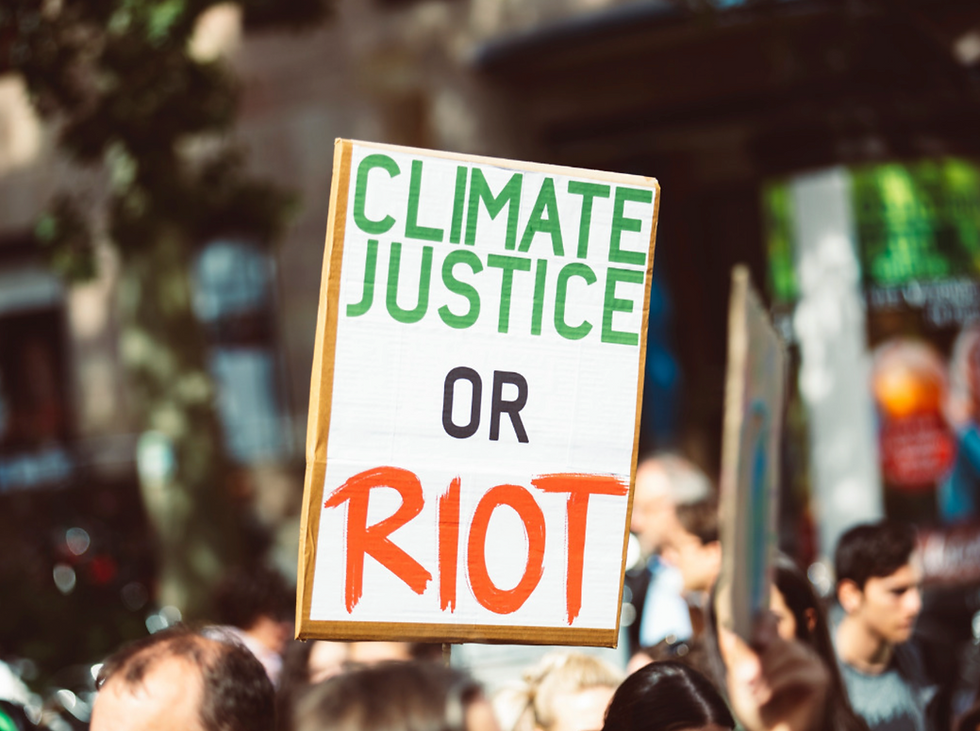Updated: Jul 14

As I sat one evening, hoping to retrieve a care package in the horrifically long line to the mailroom, I heard a raspy voice scream at the students ahead of me. It was the head of the Sustainability Committee, a club I was a part of. She was arguing about the waste of cardboard boxes contributing to the environment, and how reducing the number of packages we receive at school was imperative in contributing positively to it. As I got closer and closer to the mailroom window, I thought to myself, “Why does she need to be so angry all the time?” As I explored this question even more, I began to notice how radical climate activists are often portrayed in the media, with much of the coverage focusing less on their message and more on their anger.
The concept of activism has always been a delicate topic, but it brings a sense of inspiration and courage to many. The sight of hundreds–or even thousands–marching for justice and rights evokes a sense of pride, even in those with no affiliations with the protests. But climate activism in particular has been losing its public momentum in recent years, not just for the fundamental changes activists try to bring, but for the way it spreads its message to the world: loud and confrontational. And it brings forth the question: “Why do climate activists seem so angry all the time?”
A distinction between climate activism and other types of activism must first be made in order to understand the intensity of climate activists’ frustration. What separates “climate injustice” from other forms of injustice is its universal consequence–the fact that, in the end, when Earth has been damaged beyond repair, all groups of people, regardless of their stance on climate change, will be affected. In most other forms of activism, there are two clear parties involved: the offenders and the offended. For these activists, activism generally means advocating for issues dearest to them and their communities. If their actions fail to convince the other party, they face setbacks often contained within specific groups.
For climate activists, however, their battle revolves around a widely accepted truth: our planet is on the verge of disintegration. In the matter of climate change, people outside the conversation, or those who may have no view on the issue at all, will face the same fate in due time. This gives climate activists a sense of certainty, knowing that public support for their cause is inevitable. This confidence sometimes influences the way they engage in activism. Since the urgency of climate change seems to justify their actions, some activists may feel less motivated to consider rhetoric and persuasion when they speak out.
Is the anger of the climate activist really fueled by the confidence that their opponents will surrender and kneel at their feet? This is not always the case. For many, anger is a way to channel the frustration and anxiety they constantly live with. Activists in any movement face opposition and backlash, which naturally establishes an ambiance of anxiety and unease. Climate activists, however, experience an even deeper layer of distress. It is not only resistance to their cause but also the terrifying reality they will need to welcome into their lives if their activism fails. In other words, the failure to exact change in the world does not mean political or social setbacks; it means a radical and irreversible change in the Earth’s climate: certain death. They face a constant torrent of fear of failure to the point where they feel the only way their voices can be heard is through assertive and aggressive methods. Anger and speaking out are how climate activists relieve the burden on their shoulders of the premonition of climate change.
But we cannot ignore that the demanding approach of radical climate activists often feels overwhelming. As the matter of climate change affects every single person on the planet, the monumental changes these activists advocate for require a collective commitment on an unprecedented scale. From the gradual yet complete elimination of fossil fuels in our energy grid to the adoption of costly changes in many countries’ legislatures, most of these demands seem close to unrealistic within the current global community.
There, however, are ways in which both activists and those who hardly consider themselves activists can make climate action more relatable. Take my grandmother, for example. My maternal grandparents arrived on the island of Jeju more than 25 years ago. Realizing that the extent of their property measured about 70,000 square feet of land, my grandmother hoped to transform the area into gardens and fields where she could grow her own plants and crops. She grew flowers and plants so that wild beasts could eat and bees and butterflies could pollinate. She soon started donating seeds from her own garden to her neighbors and taught them how to grow and care for the plants. In 2019, she was awarded a medal by the island for her efforts in the conservation of plant species. To this day, my grandmother refuses to call herself a “climate activist”. She did not force herself to contribute positively to the environment. Instead, she became aware of the issues of the greater world and sought to help by doing what she loved most: gardening.
What we can learn from this story is this. Whether a person is a climate activist or not, one who is aware of climate change lives under a lingering fear of the unknown and Earth’s future. Instead of responding with frustration or anger at the world’s ignorance, a more effective approach may be to make climate action something deeply personal. Be it adopting more mindful habits in daily life or integrating environmental awareness into an existing passion, we can make sustainability a natural lifestyle–something personal, intimate, and truly sustainable. All we can do now, I guess, is hope and pray that our small efforts even the odds.

